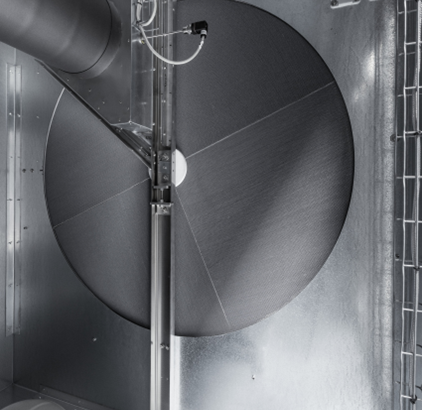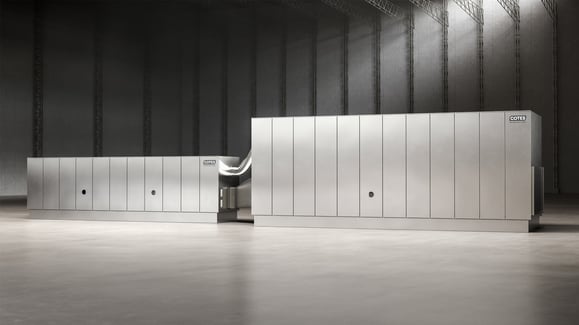Ensuring Optimal Humidity Control for High-Quality Batteries
In battery gigafactories, maintaining precise humidity levels in battery dry rooms is crucial for ensuring the quality and performance of battery components throughout the production process. If humidity levels deviate from optimal conditions, it can result in defects in batteries, ultimately affecting their reliability and performance. By understanding the interplay between rotor dynamics and dew points in adsorption dehumidifiers, gigafactories can effectively control humidity levels, minimising the risk of moisture-related defects and ensuring consistent production of high-quality batteries. Essentially, getting the humidity control right is essential for gigafactories to produce top-notch batteries efficiently and reliably.
Understanding Adsorption Rotor Dynamics and Dew Point in Dehumidifiers
Adsorption rotors play a pivotal role in the functionality of dehumidifiers, influencing their ability to control humidity levels effectively. Here's an exploration of the relationship between rotor dynamics, dew points, and relative humidity, along with their underlying physics, benefits, and limitations.
1. Rotor Dynamics
Rotors serve as the primary component responsible for adsorbing moisture from the air in dehumidifiers. The efficiency of this process relies heavily on the design and dimensions of the rotor. A wider rotor has the potential to accommodate more desiccant material, thereby increasing its adsorption capacity.

2. Relation to Dew Points and Relative Humidity
Dew point and relative humidity are critical metrics in assessing the effectiveness of dehumidifiers. The dew point represents the temperature at which air becomes saturated with moisture, leading to condensation. Lowering the dew point is essential for reducing humidity levels and preventing moisture-related issues.
The relationship between rotor width and dew point is complex. While widening the rotor can theoretically enhance adsorption capacity and contribute to lower dew points, practical limitations come into play. These limitations include mechanical stresses on the rotor and increased energy requirements for rotation, which can offset the potential benefits of a wider rotor.
3. Physics Behind Rotor Width and Dew Point
From a physics standpoint, widening the rotor increases the system's complexity and entropy generation during the adsorption and regeneration processes. Additionally, structural mechanics dictate that larger rotors experience higher mechanical stresses and strains, posing challenges in design and manufacturing.
4. Benefits and Limitations
Widening the rotor can improve adsorption capacity and, in theory, contribute to lower dew points. However, this enhancement comes with drawbacks. Greater mechanical stresses increase the risk of structural failure, while higher energy requirements for rotation lead to increased operational costs.
Exploring the Benefits of a 3-Rotor Solution for Dehumidification
Especially for achieving very low dew points like -40°C down to -60°C and lower, a 3-rotor solution presents a compelling approach to overcoming the limitations associated with achieving very low dew points in dehumidifiers. Scientifically, this multi-rotor configuration offers several advantages that enhance moisture removal efficiency and reduce regeneration temperature requirements. By distributing the workload across multiple rotors, each undergoing a sequential drying cycle, the strain on individual rotors is minimised. This division of labour allows for more effective moisture removal, facilitating the attainment of lower dew points. Furthermore, the reduced stress on each rotor during regeneration translates to lower regeneration temperature requirements.
From a thermodynamic perspective, this signifies a more efficient utilisation of energy, as less heat is needed to reactivate the desiccant material. Lower regeneration temperatures not only contribute to energy savings but also enable the possibility of utilising renewable energy sources for regeneration. Consequently, a 3-rotor solution offers a promising avenue for achieving optimal humidity control in dehumidification systems, balancing efficiency, sustainability, and performance.
Benefits of Cotes Ultradry with 3 rotors
- Enhanced moisture removal capabilities, ensuring low humidity levels for battery storage
- Improved energy efficiency due to lower regeneration temperature requirements
- Potential for utilising renewable energy sources for regeneration, reducing environmental impact
- Increased reliability and longevity of the dehumidification system, minimising maintenance requirements

Learn more about the 1, 2 and 3 dehumidification stages
In summary, in the context of battery gigafactories, maintaining precise humidity levels is vital for ensuring the quality and reliability of battery components. Deviations from optimal humidity conditions can lead to defects in batteries, impacting their performance. Understanding the relationship between rotor dynamics and dew points in adsorption dehumidifiers is crucial for controlling humidity effectively in gigafactory environments. While widening the rotor can enhance moisture removal efficiency and contribute to lower dew points, it also poses challenges such as increased mechanical stresses and energy requirements. However, a 3-rotor solution presents a promising approach to overcome these challenges by offering enhanced moisture removal capabilities and improved energy efficiency. By optimising humidity control processes, gigafactories can produce high-quality batteries efficiently and reliably, meeting strict industry standards.
